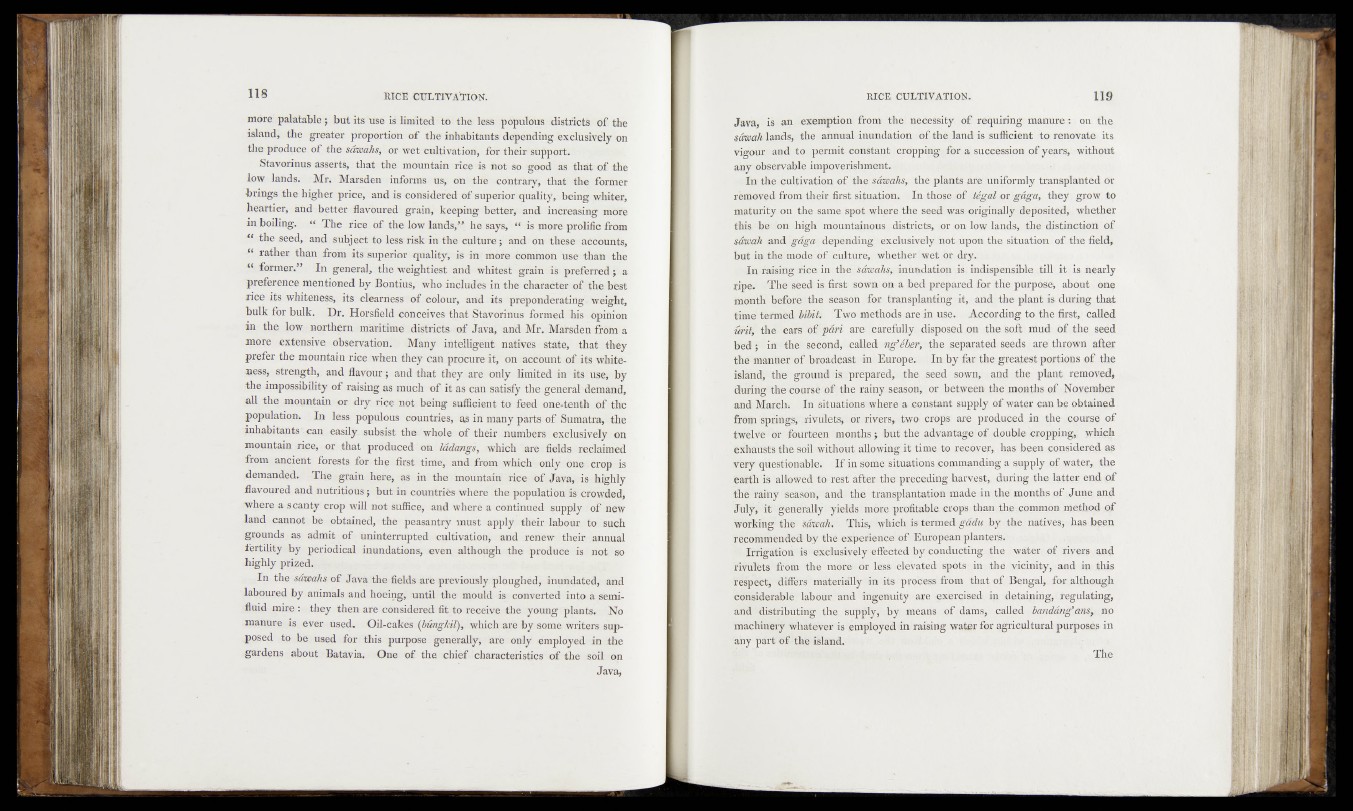
more palatable; but its use is limited to the less populous districts of. the
island, the greater proportion of the inhabitants depending exclusively on
the produce of the sdwahs, or wet cultivation, for their support.
Stavorinus asserts, that the mountain rice is not so good as that of the
low lands. Mr. Marsden informs us, on the contrary, that the former
brings the higher price, and is considered ofsuperjor quality, being whiter,
heartier, and better flavoured grain, keeping better, and increasing more
in. boiling. “ The rice of the low lands,** he says, “ is more prolific from
“ the seed, and subject to less risk in the culture ; and on these accounts,
“ rather than from its superior quality, is in more common use than the
“ former.” In general, the weightiest and whitest grain is preferred ; a
preference mentioned by Bontius, who includes in the character of the best
SShe its whiteness, its clearness of colour, and its preponderating1« weight,
bulk for bulk. Dr. Horsfield conceives that Stavorinus formed .his Opinion
in the low northern maritime districts of Java, and Mr. Marsden from a
more extensive, observation. Many intelligent natives state, that they
prefer the mountain rice when they can procure it, on account of its whiteness,
strength, and flavour; and that they are only limited in its "use, by
the impossibility of raising as much of it as can satisfy the general demand,
all the mountain or dry rice not being sufficient to feed onedenth óf the
population* In less populous countries, as in many parts of Sumatra, the
inhabitants can easily, subsist the whole of their numbers exclusively on
mountain rice, or that produced on ladtmgs, which are fields reclaimed
from ancient forests fcr the first time, and from which only one.crop is
demanded. The grain here, as in the mountain rice of Java, is .highly
flavoured and nutritious; but in countries where the population is crowded,
where a scanty crop will not suffice, and where a continued supply of ;new
land cannot be obtained, the peasantry must apply their labour to such
grounds as admit of uninterrupted cultivation, and renew their annual
fertility by periodical inundations, even although the produce is riot so
highly prized.
In the sdwahs of Java the fields are previously ploughed, inundated, and
laboured by animals and hoeing, until the mould is converted into, a semi
fluid mire : they then are considered fit to receive the young plants. No
manure is ever used. Oil-cakes (bmgkil), which are by some writers sup-
4>psed to be used for this purpose generally, are only employed in .the
gardens about' Batavia. One of the chief characteristics of the soil on
Java,
Java, is an exemption from, the necessity, of requiring manure: on the
someth lands, the annual inundation of the land is sufficient to renovate its
Vigour and to. permit constant.: cropping for a succession of years, without
any observable impoverishment. I
In the cultivation of the' sawaks, the plants are uniformly transplanted or
removed from their first situation. In those lof legal, or gaga, they grow to
maturity on the same, spot where the seed: was originally deposited, whether
this he. on high mountainous districts, or on. low lands,, the distinction, of
sdwah and ,gaga depending exclusively not upon the situation of the field,
but in the mode of culture, whether'wet or dry. ..
In. raising rice's in. the saxnahs, inundation is. indispensible till it is nearly
tipei The seed is first sown on a bed prepared'for ther purpose, about one
month before the season for transplanting it, and the plant is during that
time, termed Mbit, Two methods are in use. According to the first, called
writ, the ears* 'of-1 pari are: carefully disposed on the soft mud of the seed
bed;- -in?1 the» second, called--ngiebjsr,'rthe separated seeds ,are thrown r i te
the-manner of broadcast in Europe. In by far the greatest portions ©f the
island, ther'groundtis;fprepared, the, seed sown, and the plant removed^
during-theeoursfe'd^;the rainy season, or between: the months «? Noxewfe#
and March. Imbitriations where a constant supply of.Wjate can be obtained
from springs,■irivuletsy' dr rivers, two<-crops are produced in thft.fgfUffif of
twelve^oT lodpteen 'months ;.dbiuf the advantage ofudouhle cropping, which
’exfefctstfs' the soiVwftfisut allowingi.it time to recoyep, ha«, been considered as
very questionable. If in some situationshommanding a riypply of water, the
erifh.is allowed to. rest rite-the .preceding harvest,,• during.the latte? end of
the rainy ■ season, and the transplantati'OB'ma'de in-the! months .of June an.d
Julyy if'lgerie¥ally yields' more profitable crops than the-..eomm.on! method .of
working the savoak. This, which is termed^ fchyvtbe natives; has been
recommended3by tire experience ©f European planters.
Irrigation is ^elnsively'effected by.conducting the .water of rivers arid
rivulets from -the more or less: elevated spots; in, the vicinity, and in,this
respect, differs materially in its process, from that of Bengali-for although
considerable labour and ingenuity are -exercised, ip fetainirigjLfegulating,
and distributing the supply, ;\by means of dams, called handmg’mSy no
machinery whatever is employed in raising water for agricultural purposes in
any part rif -the- island.
The